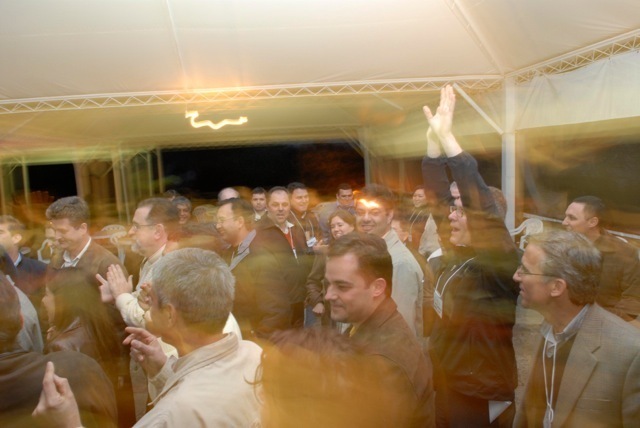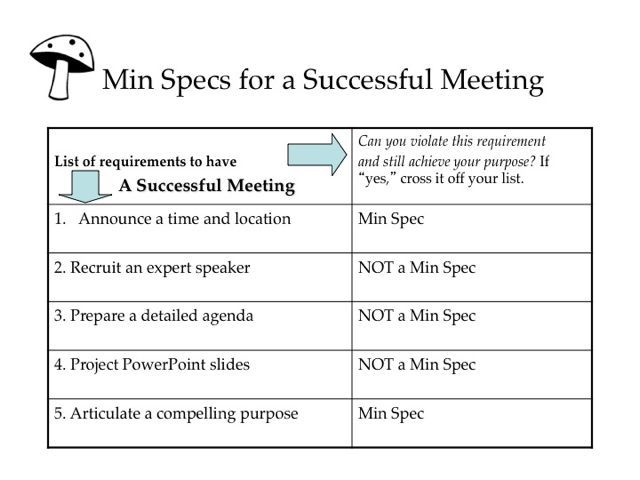![]() Min Specs
Min Specs
Specify Only the Absolute “Must dos” and “Must not dos” for Achieving a Purpose (35-50 min.)
A designer knows perfection is achieved not when there is nothing more to add but when there is nothing more that can be taken away. – Antoine de Saint-Exupery
What is made possible? By specifying only the minimum number of simple rules, the Min Specs that must ABSOLUTELY be respected, you can unleash a group to innovate freely. Respecting the Min Specs will ensure that innovations will be both purposeful and responsible. Like the Ten Commandments, Min Specs are enabling constraints: they detail only must dos and must not dos. You will eliminate the clutter of nonessential rules, the Max Specs that get in the way of innovation. Often two to five Min Specs are sufficient to boost performance by adding more freedom AND more responsibility to the group’s understanding of what it must do to make progress. Out of their experience in the field, participants shape and adapt Min Specs together, working as one. Following the rules makes it possible for the group to go wild!
Five Structural Elements – Min Specs
1. Structuring Invitation
- In the context of a challenging activity, a new initiative, or a strategic bottleneck, invite the participants to first generate the entire list of all the do’s and don’ts that they should pay attention to in order to achieve a successful outcome. This is the list of maximum specifications (Max Specs).
- After the list of Max Specs has been developed, ask the participants to reduce it to the absolute minimum needed to achieve their purpose. Invite them to sift through the list one item at a time and eliminate every rule that gets a positive answer to the question, “If we broke or ignored this rule, could we still achieve our purpose?”
2. How Space Is Arranged and Materials Needed
- Groups of 4 to 7 chairs around small tables
- Paper to record Max and Min Specs
3. How Participation Is Distributed
- Everyone involved in the activity or program can participate
- Everyone has an equal opportunity to contribute
4. How Groups Are Configured
- Start individually then small groups of 4 to 7
- Whole group for sharing
5. Sequence of Steps and Time Allocation
- Generate the list of all must-do and must-not-do activities (Max Specs), at first alone for one minute then consolidate and expand in the small group for five minutes. Make list as complete as possible in a short time. 6 min.
- Each small group tests each spec on its Max Spec list against the purpose statement. If the spec can be violated and the purpose still achieved, the spec is dropped from the list. 15 min.
- Do a second round if needed. 15 min.
- Compare across small groups and consolidate to the shortest list. 15 min.
WHY? Purposes
- Evaluate and decide what is absolutely essential for success
- Open space for new possibilities
- Reduce frontline frustration and free people from micromanagement
- Focus or redirect resources and energies where it matters
- Help guide scaling up and spreading innovations with fidelity
- Simplify strategy in fast moving markets
Tips and Traps
- Focus attention on a tangible challenge, not a platitude
- Start with a complete list of dos
- Include as many players/stakeholders as possible
- Be ruthless in dropping dos: don’t allow max specs to creep in
- Do extra rounds as needed
- Make the Min Specs official! Live by them (no “yes but”)
- Give more weight to direct experience in the field rather than conceptual knowledge
- Keep the Min Specs alive by adapting them based on field experiences and Simple Ethnography observations
- If groups are having difficulty, you may need to circle back to clarify purpose and make sure that it is down to what is truly important.
- Learn more in Edgeware and from Kathy Eisenhardt at Stanford [YouTube]
Riffs and Variations
- Do a second round of purpose testing with the question, “If you followed all the Min Specs except this one, would you achieve your purpose?” If yes, you can drop that spec from the list.
- Instead of developing Min Specs for the present, ask people to speculate on what Min Specs should shape action in the future. Use them to inform the present.
- Do Min Specs with virtual groups by using the chat function to share answers to each “can you violate this specification and achieve your purpose?” question. When your Min Specs list is getting shorter and tighter, open the voice conversation to all.
- Simple Ethnography or Nine Whys may reveal implicit or tacit Min Specs (dig deeper!)
Below: Min Specs guide a self-organizing pattern in Brazil
Examples
- Senator Lynda Bourque Moss used Min Specs to identify the must dos and must not dos for all the stakeholders to share responsibility for preventing the habit of driving while intoxicated and support new state legislation. Read Lynda’s story, “Passing Montana Senate Bill 29” in Part Three: Stories from the Field.
- After a company-wide Open Space meeting, Alison Joslyn developed a set of Min Specs with the new project leaders of a corporate turnaround. See “Turning A Business Around” in Part Three.
- Include Min Specs with any assignment given or received.
- Examples from businesses, London Business School--Donald Sull [YouTube]
Attribution: Liberating Structure developed by Henri Lipmanowicz and Keith McCandless. Inspired by professor Kathleen Eisenhardt and author Paul Plsek (see Zimmerman, Lindberg, and Plsek Edgeware).
Collateral Material
Below: Presentation materials we use to introduce Min Specs

